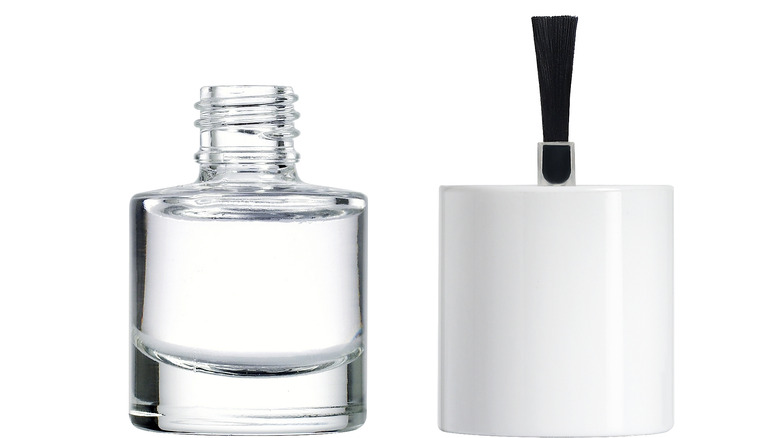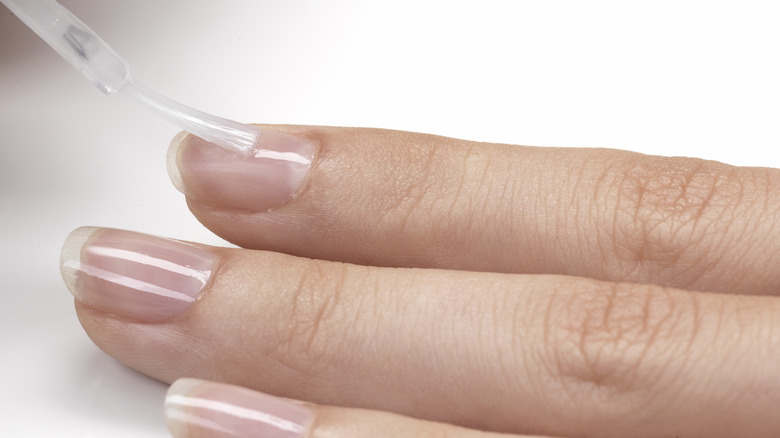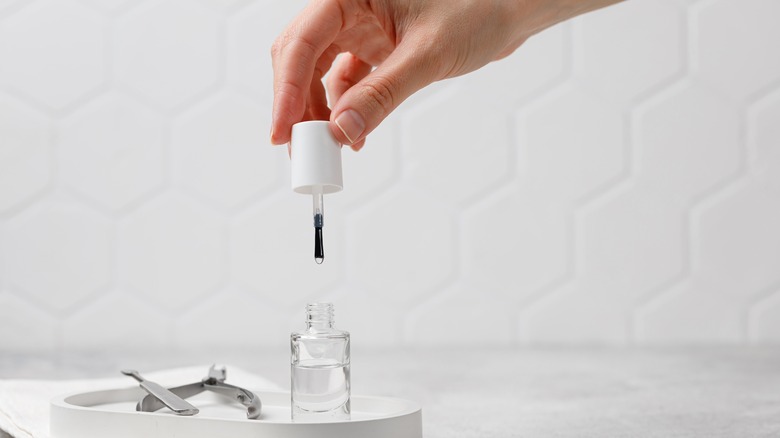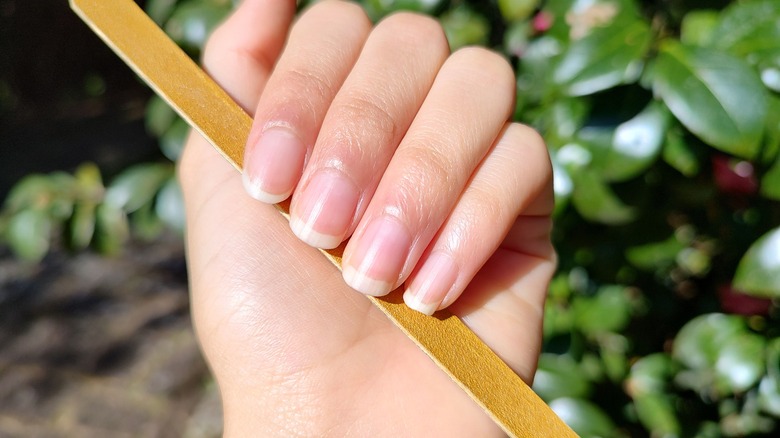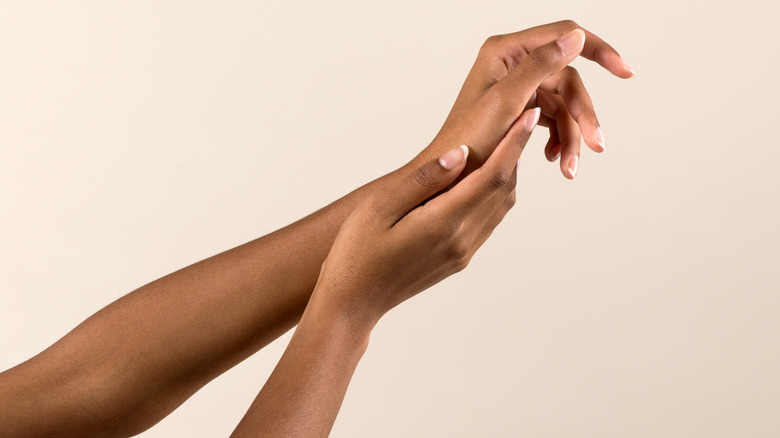What's The Deal With Nail Strengtheners? Let Us Explain
Breakups are terrible, but have you ever gotten your acrylics removed only to be faced with brittle, damaged nails? Yeah, we've been there, too. And there are a couple of reasons why that could be happening.
Your natural nails are composed of keratin, a protein that also makes up a huge portion of your hair and skin. When your nails go through trauma or damage, it can weaken the nail plate, causing cracks that eventually lead to breaking or chipping off. This nail-damaging trauma could be from excessive nail polish, acrylics, or an overfrequent gel-x appointment with your nail tech. Other causes of brittle nails include a nutrient-poor diet, certain health conditions, leaving your hands in water for too long, and fingernail biting, otherwise known as onychophagia.
So with all these factors taking their shots at your poor nails, whatever can you do to protect and strengthen them? Well, we're glad you asked because nail strengtheners will be your new favorite nail product.
What are nail strengtheners, and how do they work?
Nail strengtheners are products that contain a system of nutrients to protect and repair your nails. As mentioned earlier, brittle or weak nails are usually caused by a diet problem, a health condition, or physical trauma. This is why nail strengtheners use the two-pronged approach of hardening your nails to preserve your new nail growth while supplying moisture and nutrients to the deeper layers of your nail plate. This way, your already-grown nails are safe from the harsh elements of daily typing, clicking, and washing while the nutrients in the strengthening treatment encourage new nail growth.
The nail strengtheners' nutrient system contains film formers that protect your nails and nutrients like hyaluronic acid, vitamins, oils, and keratin for further hardening and repair. Overall, nail strengtheners are on our rotation for maintaining strong, healthy nails, and here's how to apply them.
How do I apply my nail strengthening treatment?
Nail strengtheners come in different packaging, like tubes or regular polish jars with applicator brushes. Some even come tinted or are nail polish hybrids. But no matter the packaging, the application rules are the same, and it all starts with clean, unpolished nails. To deliver the nutrients, the nail strengtheners must penetrate your nail plate. This means that having nail polish (or any nail add-ons in general) on your nails makes it harder for the strengthener to access deeper layers of your nail plate, rendering it ineffective. Instead, ensure you wash your hands, dry, and trim the nails to prepare them for the treatment.
You do not need to do anything fancy, like filing or buffing, to get the strengthener to penetrate deeply. Apply the treatment with the applicator that comes with the jar or massage with your fingers. Also, strengtheners are usually less long-lasting on the nails than polish as they contain different film formers in various concentrations. So yes, you will need to remove the treatment with a nail strengthener remover in about a week or shorter, depending on the instructions that come with it. And lastly, repeat the process after removing the previous coat for the best results.
Now that you know how to apply your nail strengthener, here are a few things to consider while using one.
What do I look out for when using a nail strengthener?
While they do sound magical, nail strengtheners are anything but. And if you're looking for quick results, you might be disappointed. Like with hair, nails have their own growth time, and it takes your nails about a month to grow an extra 3 millimeters on average. This means you must be consistent with your nail-strengthening treatment to see any visible results. However, per some experts, using several nail strengthener brands can lead to slower results, so it's advisable to find the best one you can afford and stick to it.
Also, reading the ingredient lists of your nail-strengthening treatments is important. Some nail strengtheners can contain harsher film-forming chemicals or allergens. Sure, it's exciting to get a new beauty item and want to dive right in, but please conduct a small patch test on the inside of your wrist or the side of your neck and observe for at least 24 hours before trying them on your nails.
What's the difference between a nail strengthener and a nail hardener?
In the quest for stronger, healthier nails, you may have discovered another nail product similar to your nail strengtheners, called nail hardeners. Like most nail straighteners, these are usually clear, come in a polish jar with an applicator, and provide some much-needed strength and rigidity to your brittle nails. However, they are not the same.
The major difference is that nail strengtheners strengthen the nail and provide nutrients to help repair it. Nail hardeners, on the other hand, only form a hard film that prevents your nails from chipping or cracking. Over time, nail strengtheners offer more repair benefits to your nails compared to nail hardeners and are considered a more long-term-friendly nail product. This ties back into their ingredient lists, where nail hardeners may contain only film-forming ingredients and solvents. In contrast, nail straighteners contain nutrients and keratin and, as such, do not harden as much as nail hardeners, which is their sole function.
How else can I take care of my brittle nails?
Nail strengtheners are amazing for preserving nail growth and repairing damaged nails in the long run, but they're not the only step you can take to achieve stronger nails. For one, your brittle nails could be caused by a lack of nutrients like minerals and vitamins like selenium and biotin in your diet, which are important for proper nail and hair growth. To solve this, incorporate biotin-rich foods like eggs and avocados into your diet and add some supplements while you're at it. Health conditions like psoriasis can also affect your nails, so it's important to check with your health provider to ensure your weak nails are not a sign of an underlying problem.
Are you getting way too many manicures done? You might also need to slow that down and let your nails breathe through nail cycling. Excessive manipulation of your nails can damage your nail beds and lead to cracking and chipping away your nail. And, of course, stay hydrated, as a lack of water can dry out your nails.

